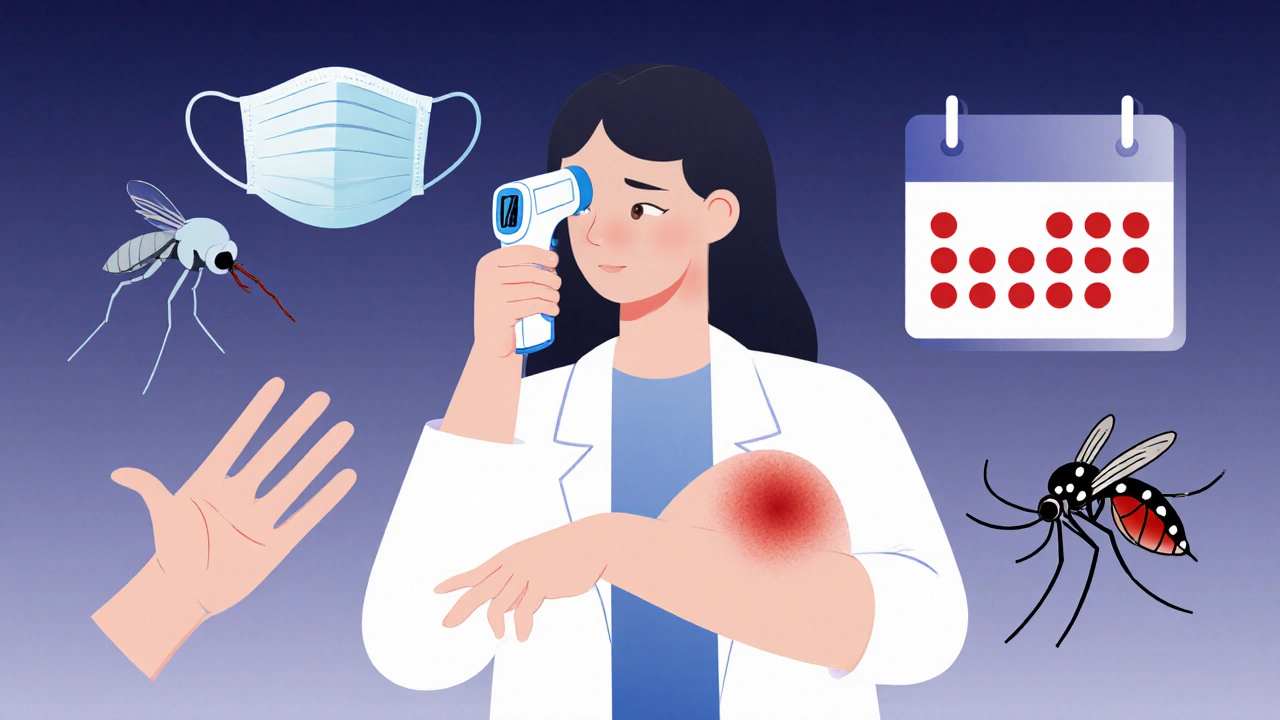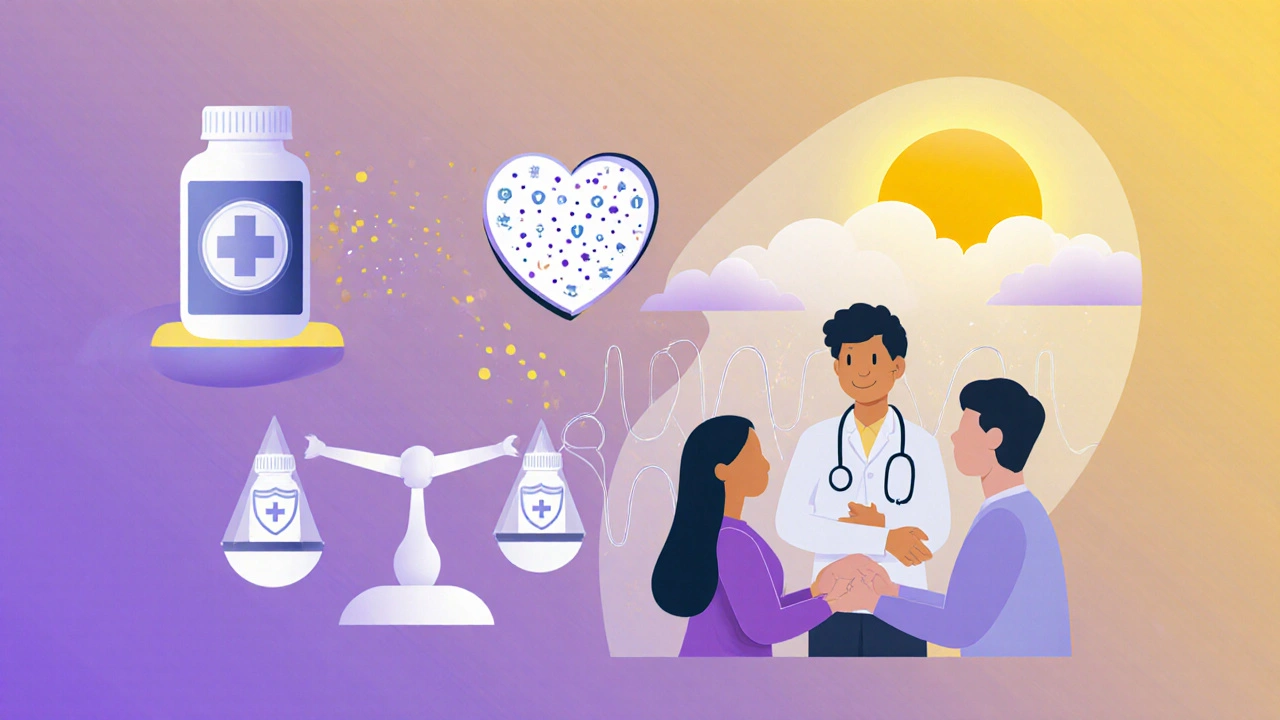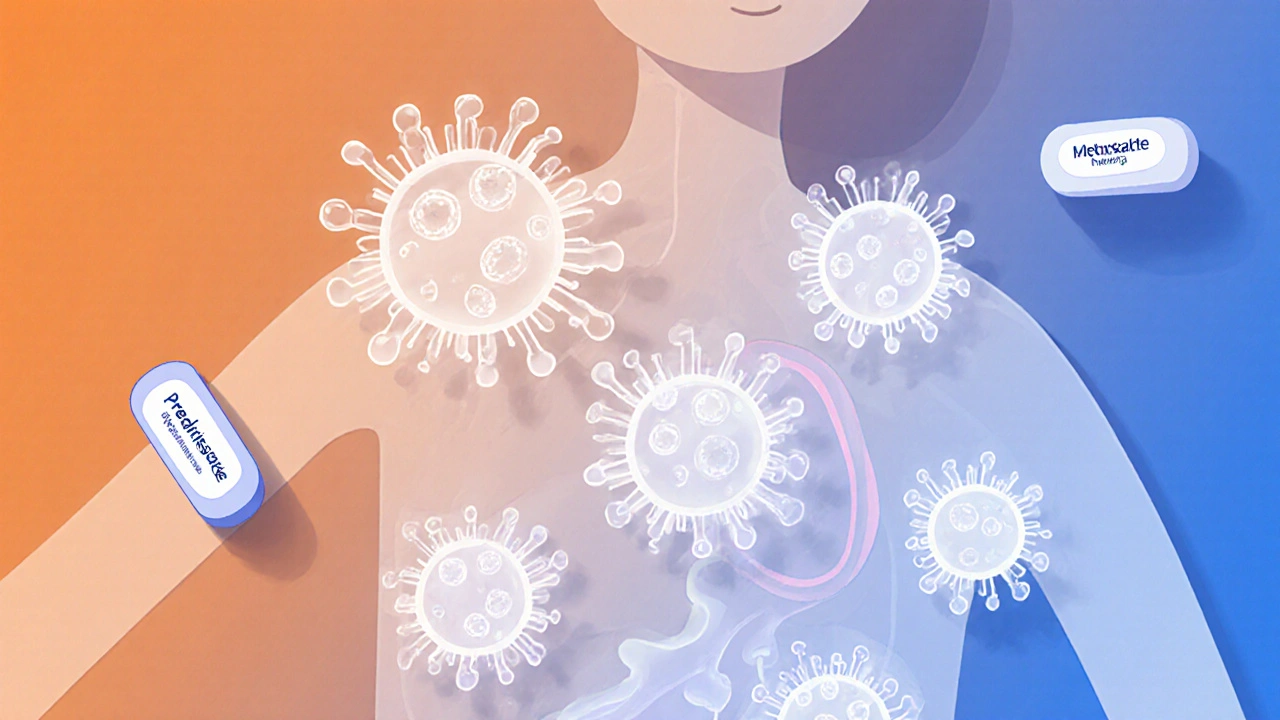27 Oct 2025
- 9 Comments
Immunocompromised Symptom Risk Checker
How this tool works
Based on medical guidance for immunocompromised patients, this tool helps assess potential infection risk from your symptoms. Remember: This is not a substitute for professional medical advice.
Results
When your immune system is weakened-whether from disease, transplant, or long-term medication-you don’t just get sick more often. You get sick differently. And that’s where the real danger lies.
What Does It Mean to Be Immunocompromised?
Being immunocompromised means your body’s defense system isn’t working the way it should. You might not run a fever when you have an infection. Your cough might not get worse. Your redness or swelling might stay quiet. That doesn’t mean you’re fine. It means your body can’t sound the alarm.This isn’t rare. About 7.6% of people in the U.S.-roughly 24 million-have an autoimmune disease like rheumatoid arthritis, lupus, or Crohn’s disease. Many of them take drugs to quiet their overactive immune systems. Others are on these medications after an organ transplant. Some are undergoing chemotherapy. All of them are walking a tightrope: balancing the need to control disease against the risk of life-threatening infections.
The Medications That Weaken Your Defenses
Not all immunosuppressants are the same. Each works differently-and each carries its own set of risks.Corticosteroids like prednisone are the most common. They’re powerful, fast-acting, and often used for flare-ups. But take more than 20mg a day for over two weeks? Your infection risk jumps. A 2012 study of over 4,000 patients found steroid users had a 60% higher chance of getting an infection than those not on steroids. The higher the dose and the longer you’re on it, the worse it gets.
Methotrexate is the go-to for rheumatoid arthritis and other autoimmune conditions. It’s not glamorous, but it works. About 70% of users report good control of their disease. But half of them quit within a year because of side effects: nausea, fatigue, mouth sores, liver stress. Monthly blood tests are mandatory to catch liver or bone marrow damage early.
Azathioprine knocks down your T and B cells-the soldiers that fight viruses and bacteria. It’s linked to serious infections like Pneumocystis pneumonia, hepatitis B reactivation, and even a rare brain infection called PML caused by the JC virus. Leukopenia (low white blood cell count) is its most dangerous side effect. If your white count drops too low, even a cold can turn deadly.
Biologics like Humira, Enbrel, and Remicade target specific parts of the immune system. They’re effective, but they’re also the riskiest. Studies show they’re significantly more likely to cause serious infections than older drugs like methotrexate. Herpes zoster (shingles) is common. So are tuberculosis reactivations and fungal infections. One Reddit user in an autoimmune support group shared how they ended up in the ICU after a simple skin infection turned into sepsis while on a TNF inhibitor.
Cyclosporine and tacrolimus are used after transplants. They keep your body from rejecting the new organ-but they also make you vulnerable to viruses like CMV, EBV, and polyomavirus. One transplant patient described tacrolimus as "life-changing," but added, "I check my temperature twice a day. I avoid crowds. I wear a mask at the grocery store. I don’t take chances."
Why Infections Are Harder to Spot
Here’s the scary part: your symptoms might not show up the way they should.Normal infections come with fever, chills, swelling, pain. But corticosteroids suppress those signals. You might have pneumonia and feel fine. You might have a urinary tract infection and just feel tired. No fever. No burning. No urgency. That’s not normal. That’s dangerous.
Doctors call this "atypical presentation." It’s why immunocompromised patients often show up in the ER with sepsis-not because they ignored symptoms, but because they never had the usual warning signs. Dr. Francisco Aberra and Dr. David Lichtenstein pointed this out back in 2005, and it’s still true today.
That’s why vigilance matters more than ever. If you’re on immunosuppressants, you need to know your baseline. What does your energy level normally feel like? What’s your usual body temperature? Any new ache, rash, or weird fatigue? Don’t wait. Call your doctor.
What You Can Do to Stay Safe
You can’t stop your medication. But you can reduce your risk.- Wash your hands like your life depends on it. At least 20 seconds. Scrub under nails, between fingers. Use hand sanitizer if soap isn’t available. The CDC says this is non-negotiable.
- Get vaccinated-before you start treatment. Flu shot? Yes. Pneumococcal? Yes. Shingles vaccine? Only if it’s the non-live version (Shingrix). Live vaccines like MMR or nasal flu spray are off-limits once you’re immunosuppressed.
- Avoid crowds during flu season. Even if you wear a mask, the risk adds up. Skip the packed mall. Avoid large family gatherings if you’re feeling unsure.
- Protect yourself from bugs that bite. The CDC warns immunocompromised people are at higher risk from mosquito- and tick-borne diseases like West Nile, Lyme, and Zika. Use repellent. Wear long sleeves. Check for ticks after being outside.
- Don’t ignore cuts or scrapes. A tiny wound can become infected fast. Clean it immediately. Use antibiotic ointment. Watch for redness spreading or pus. Call your doctor if it doesn’t improve in 24 hours.

Combining Drugs = Higher Risk
Taking two or more immunosuppressants together doesn’t just add risk-it multiplies it.For example: prednisone plus methotrexate raises infection risk more than either drug alone. Add a biologic? The danger spikes again. This isn’t theoretical. Studies show combinations lead to more hospitalizations for pneumonia, sepsis, and fungal infections.
That’s why doctors are careful. They don’t stack drugs unless absolutely necessary. If you’re on multiple immunosuppressants, your blood work needs to be checked more often-sometimes every few weeks. Your doctor should be asking: "Is this combination still needed? Can we lower the dose?"
COVID-19 Changed the Game
Early in the pandemic, everyone assumed immunocompromised patients would die at higher rates from COVID-19. The fear was real. But in 2021, Johns Hopkins researchers found something surprising: outcomes for these patients were often on par with people not on immunosuppressants.Why? Maybe because some of these drugs actually calm the dangerous overreaction the body has to the virus-the cytokine storm that kills. Maybe it’s because these patients were already being monitored closely, tested early, and treated fast.
It doesn’t mean you’re safe. But it does mean blanket assumptions are wrong. Your risk depends on your specific drugs, your age, your other health conditions, and how well you’re monitored.
What to Expect from Your Doctor
Good care doesn’t just mean prescribing the right drug. It means managing the whole picture.- Regular blood tests: CBC (to check white blood cells), liver and kidney function.
- Vaccination history review: Did you get all your shots before starting treatment?
- Screening for latent infections: TB skin test, hepatitis B panel.
- Clear instructions: What symptoms mean "call now" vs. "call tomorrow."
- Shared decision-making: Your doctor should explain the 1.6x higher infection risk with steroids-not just hand you a prescription.
If your doctor doesn’t talk to you about these things, ask. You have the right to understand your risks.

Real Stories, Real Risks
Reddit threads from patients on biologics are full of warnings: "I got shingles after my third Humira injection." "I had a UTI that turned into sepsis-I didn’t feel feverish until I collapsed." But there are also stories of hope: "I went from being wheelchair-bound to hiking again on methotrexate." "My kidney transplant saved my life, and I’m 10 years out."The truth? These drugs change lives. But they come with costs. The goal isn’t to avoid them. It’s to use them wisely-with eyes wide open.
The Bigger Picture
We’re seeing more autoimmune diseases than ever. More transplants. More long-term immunosuppression. And with that, more infections-and more drug-resistant ones.The WHO warns that by 2050, drug-resistant infections could kill 10 million people a year. Immunocompromised patients will be hit hardest. That’s why research is shifting toward smarter drugs: JAK inhibitors that target specific pathways, not the whole immune system. Personalized dosing based on genetics. Better biomarkers to predict who’s at highest risk.
For now, the best defense is knowledge, vigilance, and communication. Know your meds. Know your risks. Know when to call for help.
Can I still get vaccinated if I’m immunocompromised?
Yes-but only certain vaccines. You should get inactivated vaccines like the flu shot, pneumococcal vaccine, and Shingrix (the non-live shingles vaccine). Avoid live vaccines like MMR, varicella, or the nasal flu spray. Always check with your doctor before getting any shot. Vaccine effectiveness may be lower in immunocompromised people, but even partial protection helps.
What are the signs of a serious infection if I’m on immunosuppressants?
Don’t wait for fever. Watch for: new or worsening fatigue, unexplained chills, confusion, shortness of breath, new rash or skin redness that spreads, persistent cough, diarrhea lasting more than 2 days, or pain when urinating. Even mild symptoms can signal something serious. Call your doctor immediately if you notice anything unusual.
How often should I get blood tests while on immunosuppressants?
It depends on the drug. Methotrexate usually requires monthly blood tests during the first 6 months, then every 2-3 months if stable. Azathioprine and biologics often need testing every 1-3 months. Cyclosporine and tacrolimus require frequent monitoring of blood levels and kidney function. Always follow your doctor’s specific schedule. Skipping tests can delay detection of dangerous side effects.
Can I travel if I’m immunocompromised?
You can-but with caution. Avoid areas with high risk of mosquito-borne diseases (like Zika or dengue). Skip destinations with poor sanitation or where food/water safety is questionable. Bring extra medication, a doctor’s note, and know where the nearest hospital is. Consider travel insurance that covers medical evacuation. Always consult your doctor before planning a trip.
Do immunosuppressants increase cancer risk?
Yes, some do. Long-term use of drugs like azathioprine and cyclosporine is linked to higher rates of skin cancer and lymphoma. That’s why regular skin checks are recommended. Avoid excessive sun exposure. Use sunscreen daily. Report any new moles, sores that don’t heal, or unusual lumps. Your doctor should discuss this risk when starting treatment.
What should I do if I think I have an infection?
Don’t wait. Don’t try to tough it out. Call your doctor or go to urgent care immediately. Don’t take over-the-counter fever reducers hoping it’ll go away-that could mask symptoms. Bring your medication list. Mention you’re immunocompromised. Early treatment saves lives.


Tiffanie Doyle
October 28, 2025Just got my third Shingrix shot last week and honestly? I’m terrified of getting sick now 😅 But this post? Life saver. I didn’t even know non-live vaccines were the only safe ones. My doc never explained it like this. Thank you for writing this.
james landon
October 29, 2025Bro i took prednisone for 3 weeks last year and i swear i turned into a zombie. no energy, ate like a raccoon, cried at dog videos. but yeah i didn’t get sick so… win? 🤷♂️
Jenn Clark
October 29, 2025I’m a transplant recipient and this is spot on. I check my temperature twice a day too. I don’t go to malls anymore, even in winter. My husband jokes I’m a hermit now. But I’m alive, and that’s the goal.
L Walker
October 30, 2025Biologics are a gamble. I’ve been on Humira for 5 years. Got shingles last year. Got pneumonia the year before. But my joints? Zero pain. I’d rather have a few close calls than live in constant agony. Still… I keep a first-aid kit in my car now.
giri pranata
October 31, 2025As someone from India, I’ve seen people ignore symptoms because they think "it’s just a cold." But if you’re immunocompromised? That cold can kill. Please don’t wait. Call your doctor. Even if you think you’re overreacting. You’re not.
Stuart Rolland
November 1, 2025I’ve been on methotrexate for seven years now, and I can tell you this: the fatigue is real, the nausea is brutal, and yes, I’ve had my blood drawn so many times I’ve lost count. But here’s the thing-I went from barely being able to open a jar to hiking 10 miles last summer. The side effects are heavy, but so is the gift of mobility. I don’t take a single dose for granted. And I still get my monthly CBCs like clockwork. If you’re on this stuff, you owe it to yourself to be the most informed patient in the room.
Kent Anhari
November 1, 2025My mom’s on cyclosporine after her kidney transplant. She wears a mask to the grocery store, refuses handshakes, and still washes her hands like she’s prepping for surgery. I used to think she was being dramatic. Now I get it. She’s not being paranoid. She’s being smart.
Charlos Thompson
November 3, 2025So let me get this straight… you’re telling me that if I take a drug that turns my immune system into a sleepy sloth, I should also start living like a monk? No hugs, no parties, no sushi, no hiking? Cool. So what’s the point of surviving the disease if I can’t live?
Peter Feldges
November 4, 2025Thank you for the comprehensive breakdown. As a patient with lupus and a researcher in immunology, I appreciate the nuance-especially the point about atypical presentation. Too many clinicians still rely on fever as a diagnostic anchor. It’s outdated. The WHO’s projections on antimicrobial resistance are chilling, and immunocompromised populations are the canaries in the coal mine. Vigilance isn’t fear-it’s stewardship. 🙏